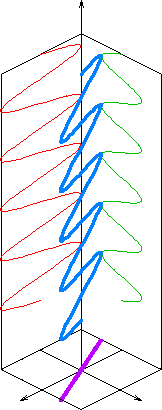Linear polarization

Diagram of the electric field of a light wave (blue), linear-polarized along a plane (purple line), and consisting of two orthogonal, in-phase components (red and green waves)
In electrodynamics, linear polarization or plane polarization of electromagnetic radiation is a confinement of the electric field vector or magnetic field vector to a given plane along the direction of propagation. See polarization and plane of polarization for more information.
The orientation of a linearly polarized electromagnetic wave is defined by the direction of the electric field vector.[1] For example, if the electric field vector is vertical (alternately up and down as the wave travels) the radiation is said to be vertically polarized.
Contents
1 Mathematical description of linear polarization
2 See also
3 References
4 External links
Mathematical description of linear polarization
The classical sinusoidal plane wave solution of the electromagnetic wave equation for the electric and magnetic fields is (cgs units)
- E(r,t)=∣E∣Re{|ψ⟩exp[i(kz−ωt)]}{displaystyle mathbf {E} (mathbf {r} ,t)=mid mathbf {E} mid mathrm {Re} left{|psi rangle exp left[ileft(kz-omega tright)right]right}}
- B(r,t)=z^×E(r,t)/c{displaystyle mathbf {B} (mathbf {r} ,t)={hat {mathbf {z} }}times mathbf {E} (mathbf {r} ,t)/c}
for the magnetic field, where k is the wavenumber,
- ω=ck{displaystyle omega _{}^{}=ck}
is the angular frequency of the wave, and c{displaystyle c}
Here ∣E∣{displaystyle mid mathbf {E} mid }
- |ψ⟩ =def (ψxψy)=(cosθexp(iαx)sinθexp(iαy)){displaystyle |psi rangle {stackrel {mathrm {def} }{=}} {begin{pmatrix}psi _{x}\psi _{y}end{pmatrix}}={begin{pmatrix}cos theta exp left(ialpha _{x}right)\sin theta exp left(ialpha _{y}right)end{pmatrix}}}
is the Jones vector in the x-y plane.
The wave is linearly polarized when the phase angles αx,αy{displaystyle alpha _{x}^{},alpha _{y}}
αx=αy =def α{displaystyle alpha _{x}=alpha _{y} {stackrel {mathrm {def} }{=}} alpha }.
This represents a wave polarized at an angle θ{displaystyle theta }
|ψ⟩=(cosθsinθ)exp(iα){displaystyle |psi rangle ={begin{pmatrix}cos theta \sin theta end{pmatrix}}exp left(ialpha right)}.
The state vectors for linear polarization in x or y are special cases of this state vector.
If unit vectors are defined such that
- |x⟩ =def (10){displaystyle |xrangle {stackrel {mathrm {def} }{=}} {begin{pmatrix}1\0end{pmatrix}}}
and
- |y⟩ =def (01){displaystyle |yrangle {stackrel {mathrm {def} }{=}} {begin{pmatrix}0\1end{pmatrix}}}
then the polarization state can be written in the "x-y basis" as
|ψ⟩=cosθexp(iα)|x⟩+sinθexp(iα)|y⟩=ψx|x⟩+ψy|y⟩{displaystyle |psi rangle =cos theta exp left(ialpha right)|xrangle +sin theta exp left(ialpha right)|yrangle =psi _{x}|xrangle +psi _{y}|yrangle }.
See also
- Sinusoidal plane-wave solutions of the electromagnetic wave equation
Polarization
- Circular polarization
- Elliptical polarization
- Plane of polarization
- Photon polarization
References
Jackson, John D. (1998). Classical Electrodynamics (3rd ed.). Wiley. ISBN 0-471-30932-X..mw-parser-output cite.citation{font-style:inherit}.mw-parser-output q{quotes:"""""""'""'"}.mw-parser-output code.cs1-code{color:inherit;background:inherit;border:inherit;padding:inherit}.mw-parser-output .cs1-lock-free a{background:url("//upload.wikimedia.org/wikipedia/commons/thumb/6/65/Lock-green.svg/9px-Lock-green.svg.png")no-repeat;background-position:right .1em center}.mw-parser-output .cs1-lock-limited a,.mw-parser-output .cs1-lock-registration a{background:url("//upload.wikimedia.org/wikipedia/commons/thumb/d/d6/Lock-gray-alt-2.svg/9px-Lock-gray-alt-2.svg.png")no-repeat;background-position:right .1em center}.mw-parser-output .cs1-lock-subscription a{background:url("//upload.wikimedia.org/wikipedia/commons/thumb/a/aa/Lock-red-alt-2.svg/9px-Lock-red-alt-2.svg.png")no-repeat;background-position:right .1em center}.mw-parser-output .cs1-subscription,.mw-parser-output .cs1-registration{color:#555}.mw-parser-output .cs1-subscription span,.mw-parser-output .cs1-registration span{border-bottom:1px dotted;cursor:help}.mw-parser-output .cs1-hidden-error{display:none;font-size:100%}.mw-parser-output .cs1-visible-error{font-size:100%}.mw-parser-output .cs1-subscription,.mw-parser-output .cs1-registration,.mw-parser-output .cs1-format{font-size:95%}.mw-parser-output .cs1-kern-left,.mw-parser-output .cs1-kern-wl-left{padding-left:0.2em}.mw-parser-output .cs1-kern-right,.mw-parser-output .cs1-kern-wl-right{padding-right:0.2em}
^ Shapira, Joseph; Shmuel Y. Miller (2007). CDMA radio with repeaters. Springer. p. 73. ISBN 0-387-26329-2.
External links
- Animation of Linear Polarization (on YouTube)
- Comparison of Linear Polarization with Circular and Elliptical Polarizations (YouTube Animation)
![]() This article incorporates public domain material from the General Services Administration document "Federal Standard 1037C".
This article incorporates public domain material from the General Services Administration document "Federal Standard 1037C".
![{mathbf {E}}({mathbf {r}},t)=mid {mathbf {E}}mid {mathrm {Re}}left{|psi rangle exp left[ileft(kz-omega tright)right]right}](https://wikimedia.org/api/rest_v1/media/math/render/svg/1f76514bed697200b46c30726b957614f01994ae)




